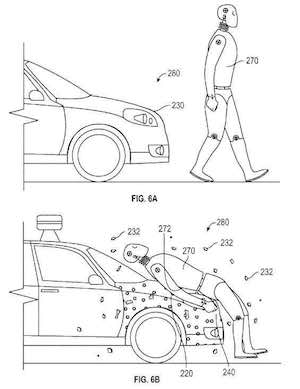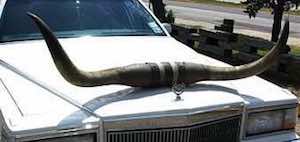A method for protecting a colliding object from a secondary impact....
Autonomously Gloogled

Modern technology is so wonderful. Among the latest inventions patented is a way to get glued to a car's hood--in the event of being scooped up (unintentionally of course) by an autonomous vehicle. As pointed out by Michael Irving (who also introduced the term "Gloogle") in a post at
gizmag.com, the
U.S. Patent 9,340,178 B1, awarded on May 17, 2016, explains it all in detail.
The Patent
If you happen to take a leisurely stroll along the road, as shown in the graph 6A, and get "rear-ended" you'll end up like shown in graph 6B--firmly (?) glued to the hood of the vehicle.
Among the claims of this patent is "A method for protecting a colliding object from a secondary impact...." Well, that's fine and dandy but better yet is to avoid any impact at all if possible. This could involve not walking along the middle of the lane--or hiding behind the bushes when you see an autonomous car approaching.
It's New and Autonomous

Of course, the roads might soon be full with autonomous vehicles of all sorts, from little 2-seaters to large sedans and 28-wheel trucks and trailers. A recent
test in Europe shows just that and some pundits think that the technology may soon overcome a
shortage in long-haul truck drivers. Many of the vehicle manufacturers, goods and
people transportation companies are literally scrambling for the "driver seat" in the field of autonomous vehicles.
Google, of course is already thinking ahead. The above mentioned patent foresees the inevitable collision with pedestrians and envisages a way to mitigate the effect of such, including potential secondary impacts. That intention is certainly quite laudable but, as I surmise, not likely to work out as envisaged in the patent.
Like so many other ideas, they sound great on paper but coming up with the materials and designs that conform to the implicit requirements is quite another kettle of fish.
One reason for that are the chemistry and physics required both of the glue and the protective shield for it. Yes, the patent foresees that problem of other stuff sticking to the glue by covering it both with an air layer above the glue and a protective "coating" above that. Even if everything else can be manufactured to the right specs, that's where the system will fail.
The idea that this coating, made from an "egg-shell-like material," will just disappear upon impact and expose all the glue in a fraction of a second to make sure you stick to the hood appears far-fetched to me. It would be of no use to simply break this coating into many small particles alone, they still would need to be moved out of the way to expose the glue. That coating also needs extra support extending from the hood out to ensure maintenance of the air layer.
However, that's not the end of problem with patents like the one above.
What Does a Patent Mean?
In other jurisdictions, in order to get a patent, one needs to provide some tangible proof that at least some crucial parts of the process(es) or product(s) being patented actually exist and work. This notion appears to have fallen by the wayside, almost completely. More and more it's only IDEAS that are receiving patent status without any evidence of actual or even just possible fulfillment of the idea.
From an
inflatable space elevator to the old standby of the
perpetual motion machine type "inventions," it appears that any idea can receive patent status now, no matter how outlandish or against all scientific evidence it may be. That kind of thinking (and actual patents granted) puts the whole principle of the patent system into question. Actually, it could just portend the end of patent offices altogether. If an applicant no longer needs to provide any proof of realism, why even apply for a patent? Isn't it all self-evident--actually I thought of that very grand novel idea of yours many years ago myself!!
So, how about MY IDEA to do away with patents altogether? Can I get a patent for that idea too? (It ought to be worth a lot!). But I have another, final thought.
Another Thought
Some folks (at least used to) take pride in displaying various "trophies" as car grill or hood ornaments, Texas longhorn displays come to mind here.

Quite frankly, I am not looking forward to the day when I may have to personally compete with such decorations for "best hood ornament," no matter how well I might be gloogled to the hood of any vehicle--of the autonomous variety or not.
Dr. Klaus L.E. Kaiser -- Bio and
Archives |
Comments
Dr. Klaus L.E. Kaiser is author of CONVENIENT MYTHS, the green revolution – perceptions, politics, and facts Convenient Myths

 Modern technology is so wonderful. Among the latest inventions patented is a way to get glued to a car's hood--in the event of being scooped up (unintentionally of course) by an autonomous vehicle. As pointed out by Michael Irving (who also introduced the term "Gloogle") in a post at gizmag.com, the U.S. Patent 9,340,178 B1, awarded on May 17, 2016, explains it all in detail.
Modern technology is so wonderful. Among the latest inventions patented is a way to get glued to a car's hood--in the event of being scooped up (unintentionally of course) by an autonomous vehicle. As pointed out by Michael Irving (who also introduced the term "Gloogle") in a post at gizmag.com, the U.S. Patent 9,340,178 B1, awarded on May 17, 2016, explains it all in detail. Of course, the roads might soon be full with autonomous vehicles of all sorts, from little 2-seaters to large sedans and 28-wheel trucks and trailers. A recent test in Europe shows just that and some pundits think that the technology may soon overcome a shortage in long-haul truck drivers. Many of the vehicle manufacturers, goods and people transportation companies are literally scrambling for the "driver seat" in the field of autonomous vehicles.
Google, of course is already thinking ahead. The above mentioned patent foresees the inevitable collision with pedestrians and envisages a way to mitigate the effect of such, including potential secondary impacts. That intention is certainly quite laudable but, as I surmise, not likely to work out as envisaged in the patent.
Like so many other ideas, they sound great on paper but coming up with the materials and designs that conform to the implicit requirements is quite another kettle of fish.
Of course, the roads might soon be full with autonomous vehicles of all sorts, from little 2-seaters to large sedans and 28-wheel trucks and trailers. A recent test in Europe shows just that and some pundits think that the technology may soon overcome a shortage in long-haul truck drivers. Many of the vehicle manufacturers, goods and people transportation companies are literally scrambling for the "driver seat" in the field of autonomous vehicles.
Google, of course is already thinking ahead. The above mentioned patent foresees the inevitable collision with pedestrians and envisages a way to mitigate the effect of such, including potential secondary impacts. That intention is certainly quite laudable but, as I surmise, not likely to work out as envisaged in the patent.
Like so many other ideas, they sound great on paper but coming up with the materials and designs that conform to the implicit requirements is quite another kettle of fish.